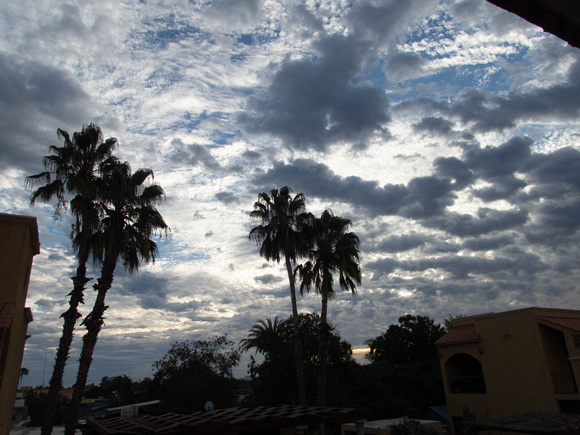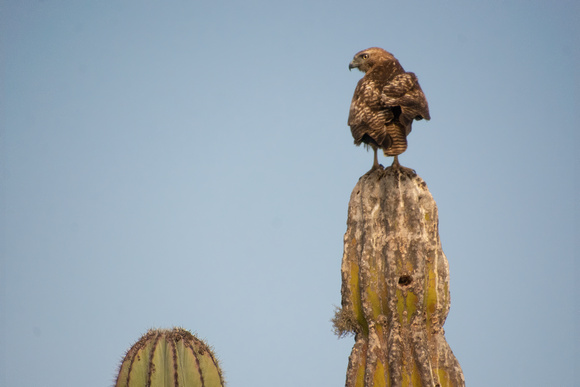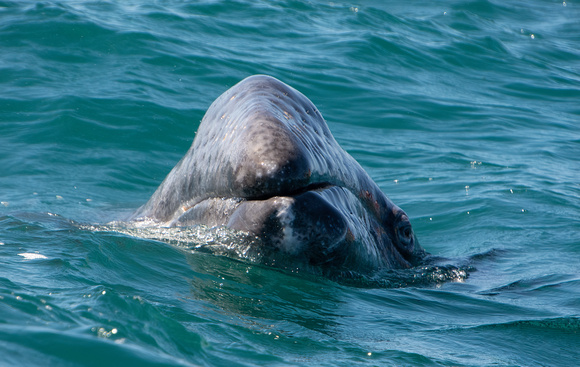Baja Sur - Travels Part 2: Magdalena Bay and Whale Camp
This is Part 2 of my trip to Baja California Sur. In Part 1 I covered an overview, trip organization and people, and field arts. This Part 2 will focus on Magdalena Bay, Gray Whales, and Whale Camp. Part 3 will cover Isla Coronado, The Mountains, and Loreto and the Estuary.
Bahía Magdalena
We drove from Loreto across the mountains to Adolfo López Mateos. Along the way I saw my first Crested Caracara. Some of them swooped right in front of the vehicle. We got good looks, but not good photos. This is when I developed "Bird Tourrette's", abruptly shouting out bird names at random moments during the rest of the trip. Some from the group in another van said they saw a Harris’s Hawk, but alas, I missed it. The closer we got to the port, the more Ospreys we saw. There were many occupied platforms along the road. I even saw an Osprey on top of a cactus with a fish.
We got in pangas, the local fishing boats, to take us to Whale Camp on the barrier island, looking for whales along the way. Pangas met us at camp for the next day of whale watching, the tour of the Mangroves, and to take us back on the last day.
Whale camp was rustic, but tents were walk-in height and were appointed with cots, sleeping bags, and a solar lamp. A central dome was used for dinner and evening lectures. Food was delicious, prepared by the camp cook. A small tent, open on one side, afforded beautiful views when using the ‘office’ (aka pee buckets). Handwashing was with salt water, and showers were welcomed when we got back to the hotel in Loreto.
The tranquility of the camp, the amazing sunrises and sunsets, and one night of clear stars, and seeing whales from the beach made this a magic place.
Watch below or Click on this link to see photos and descriptions: https://kimssight.zenfolio.com/baja_2023_skies

Sand Dunes and Mangroves
There was sand. Sand dunes. Sand in the tents. Sand in clothes. It was unavoidable.
My cats would have loved the sandbox and rodents, that make burrows in the sand and leave tiny paw prints everywhere in camp. I saw a cute rodent in the dinner tent and it scampered away before I could get a picture. The cats would not have liked the coyotes. We only saw one distantly, but saw many prints in the sand at the beach and around the tents. I thought I heard them but the sound was so distant and muffled by the sound of wind and waves.
The wind and sand are constantly changing the shape of the barrier islands. I was surprised by the lack of birds on the beach. Apparently, the constant new sand doesn't allow time for invertebrates to settle, and consequently no birds were there to eat them.
The vegetation on the dunes is all low with many vines. I did see a butterfly, but the strong winds made it hard to find insects.
Across the bay from camp, there were the Mangroves. We spent about an hour exploring them. I was surprised at what I thought was a low number of birds. I guess it is relative. One of the other boats thought there were a lot. Did they see more, or did we have a different personal baseline? Most of the birds are the same as those we have in Southern California in the winter. American Oyster Catcher is rare in California but does occur occasionally. White Ibis is extremely rare in California but common in Baja. It was a lifer for me.
Watch below or Click on this link to see photos and descriptions: https://kimssight.zenfolio.com/baja_2023_mag_bay

Gray Whales
Whales are just going about their mundane business, making babies, having babies, snacking, sleeping, playing. We come to watch them. What if whales came to our hotel to watch us eat, communicate, and, if lucky, catch us in the act. Would they approach slowly so as not to scare us or make us stop our activities? Our guides were very respectful of the whales’ space, but a few of the other boats approached rapidly or got too close. At times, I just wanted to avoid interfering with them, and breaking up couples in love. I did delight in seeing them, although you mainly see just a body part at a time.
The inlet to the bay from the Pacific could be very rough. Inside the bay, in front of our camp, it was very calm, even on very windy days. In general, we saw the mating activity take place in the deeper rougher water, and the mom’s and calves in the calmer parts of the bay. The guides also knew where the whales would be, based on the current from the tides going in and out of the channel.
When the whales were mating it was hard to distinguish which whale was which and what body part we were seeing. Two or three at a time, they were rolling around in courtship or just trying to get into position. Courtship could last over an hour. The tail was often sideways acting as a rudder. There was one body part we could identify and saw briefly. On one occasion we got great looks at, what the guides called, the "Pink Floyd".
The babies are big, but their skin has few if any of the barnacle patches that are characteristic of the Gray Whales. We would see a baby come up near the boat, and then mama could come between us and the baby. The mamas are HUGE. The babies came up for air more frequently than the patient mothers.
The babies seemed to be playing, but that is their way of developing the skills they need for their future journey north. I saw one baby with mud in its mouth. Apparently, it had been at the bottom practicing feeding.
Watch below or Click on this link to see photos and descriptions: https://kimssight.zenfolio.com/baja_2023_whales

Next Post: Part 3 will cover Isla Coronado, The Mountains, and Loreto and the Estuary.
Click here to see ALL my photos: https://kimssight.zenfolio.com/baja_feb_2023
Follow me on Facebook: https://www.facebook.com/KimMooreNaturalist/
